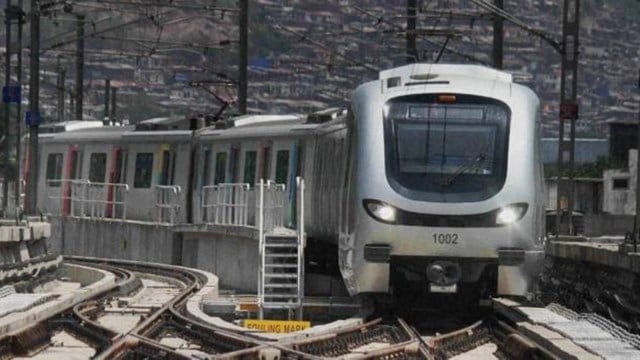BKC to Aarey in 30 minutes for Rs 50: Phase 1 of Metro Line 3 set for October opening
The minimum fare on the route will be set at Rs 10 and maximum will be Rs 50 between Aarey and BKC for a one-way trip.
 The first phase, covering 12.44km with 10 stations, will operate from 6:30am to 10:30pm, offering 96 daily trips. (File Photo)
The first phase, covering 12.44km with 10 stations, will operate from 6:30am to 10:30pm, offering 96 daily trips. (File Photo)Commuters travelling between Bandra Kurla Complex and Aarey will soon reach their destination within 30 minutes for less than Rs 50 as the first-phase of Mumbai’s long-awaited underground Metro Line 3, also known as the Aqua Line, will open to the public in October.
Currently, the same journey by road during peak traffic, particularly along the Western Express Highway, can take over an hour due to frequent traffic congestion. During peak hours, trains will be available every 6.5 minutes.
Ashwini Bhide, managing director of Mumbai Metro Rail Corporation Ltd. (MMRCL), which oversees the Metro 3 project, confirmed on Tuesday the upcoming launch, stating that the inauguration is expected in early October.
The first phase, covering 12.44km with 10 stations, will operate from 6:30am to 10:30pm, offering 96 daily trips. The minimum fare on the route will be set at Rs 10 and maximum will be Rs 50 between Aarey and BKC for a one-way trip.
Prime Minister Narendra Modi is expected to flag off Metro Line 3 during his visit to Mumbai. However, the MMRC official did not confirm anything stating that the communication from state government on the same is yet to be received.
While initially, nine rakes with eight coaches each will ply on this stretch, the frequency of trains is expected to increase especially after the full stretch is made operational by April or May 2025.
Bhide stated that a daily ridership of 4.5 lakh passengers in Phase 1 is expected, while the optimum capacity is 6.5 lakh ridership. However, the 4.5 lakh ridership will take time to build. While on the entire 33.5km underground corridor enroute to Aarey and Cuffe Parade, the daily average ridership is expected to be 13 lakh.
Last-mile connectivity, airport access
Bhide addressed concerns about last-mile connectivity, explaining that contractors working on civil construction are also responsible for developing connectivity around stations which is already happening. The MMRCL is coordinating with other agencies, including BEST and the transport department, to integrate bus, auto, and other transport services. While complete integration may not be available on day one, MMRCL plans to monitor commuting patterns and make adjustments accordingly.
The Metro will also connect to both Terminal 1 and Terminal 2 of the Mumbai airport, though seamless integration at these locations will take time. The Mumbai International Airport Ltd. (MIAL) is currently constructing multi-level structures at these stations, expected to be completed within one-and-a-half to teo years. In the interim, baggage carts, and clear signage will help commuters navigate between the Metro and the airport.
BKC Metro station: A paid area to paid skywalk with travelators is proposed to connect Metro Line 2B ITO station to BKC Metro station for commuters.
CSMIA Terminal 1 station: A pedestrian walkway at road level will connect CSMIA Terminal 1 station directly to CSMI Airport Terminal 1. In addition, a subway connecting across western highway is facilitated.
CSMIA Terminal 2 station: A paid-to-paid connection at concourse level is proposed for connection of CSMIA Terminal 2 station with Metro Line 7A station. Seamless connectivity with CSMIA T2 and Metro station is proposed at airport forecourt level.
Marol Naka Metro station: Ground-level access will connect Marol Metro Station with Metro line 1 Marol Naka Metro station. Entry/exit of both the stations are at the same footpath, thus helping in easy transfers between Metro stations.
Aarey JVLR Metro Station: Sky Walk connecting unpaid to unpaid Aarey JVLR Metro Station with Metro Line 6 SEEPZ Village station is proposed.
Why underground?
The decision to construct Metro Line 3 underground was driven by Mumbai’s unique urban landscape and space constraints. “Globally, core city areas are often connected by underground Metros to avoid disturbing ground-level activities,” Bhide explained. In Mumbai, with its dense population and limited road space, elevated tracks were not a viable option, especially in the historic and heavily commercial areas of South Mumbai.
Additionally, the proximity to the airport meant the line had to avoid air funnels and flight paths, necessitating an underground solution.
Challenges, triumphs
Building Mumbai’s first fully underground Metro has been a complex and challenging task. With narrow lanes, heritage structures, and densely populated areas, MMRCL faced numerous hurdles. The project required meticulous planning from the design stage to funding, tender preparation, and construction. The deployment of 17 Tunnel Boring Machines (TBMs) was particularly challenging due to the need to navigate beneath existing infrastructure like railways, flyovers, and utility lines.
Despite these obstacles, the MMRCL is bringing the project to a close and is eyeing for an October opening. As Bhide noted, the Metro 3 line is a critical infrastructure development for Mumbai, offering much-needed connectivity without disrupting the city’s fast-paced commercial activities.







